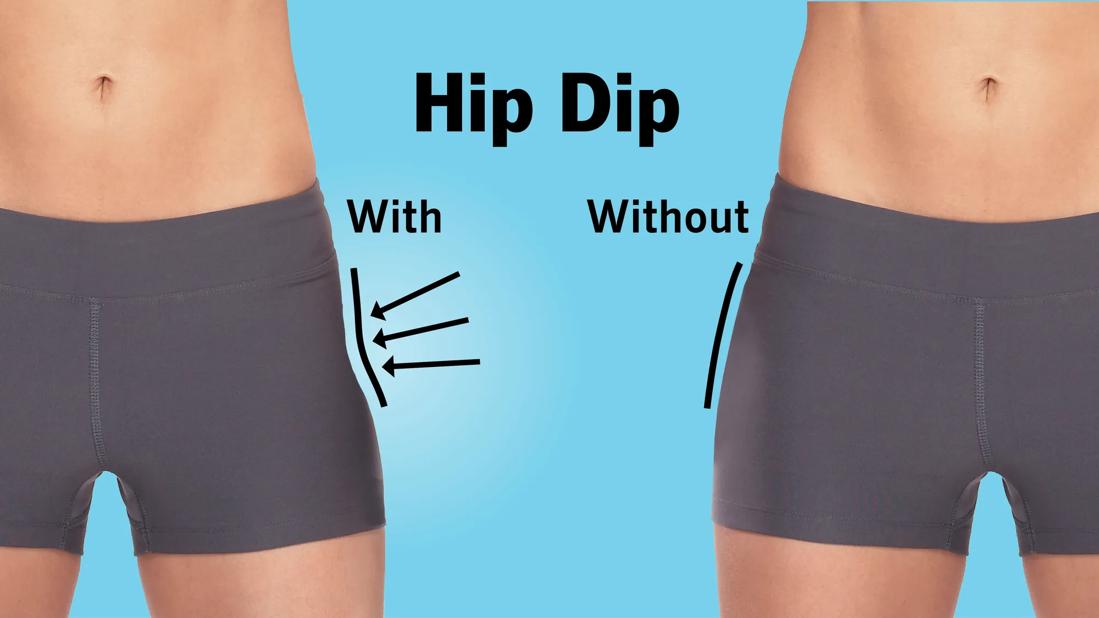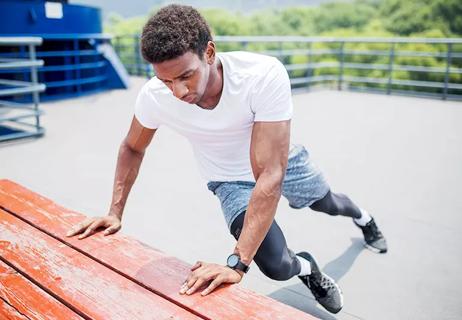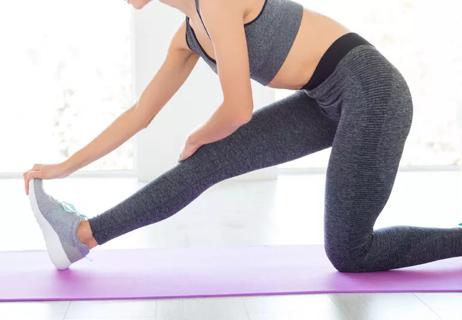Your bone structure determines whether you have a visible dent between your hips and your thighs

There’s intense pressure to have and maintain a “good body,” but what that actually means seems to change every few years.
Advertisement
Cleveland Clinic is a non-profit academic medical center. Advertising on our site helps support our mission. We do not endorse non-Cleveland Clinic products or services. Policy
In the 1990s, the goal was to be so thin that you looked unwell. In the 2000s, everybody wanted a muscular, athletic build. Then, the 2010s hit. It was an era of using cosmetic surgeries and waist trainers to achieve impossible hourglass figures and unrealistic muscle definition.
Despite the "body positivity" movement of the early 2002s, we’re still being fed plenty of messages about what curves we should and shouldn’t have, and how big those curves should and shouldn’t be.
“Hip dips,” also known as “violin hips,” are a textbook example.
Having an indentation between your hip and thigh is perfectly normal and is unlikely to impact how the joint and muscle function. But many Western cultures currently read those divots as “extra” curves. And as a result, hundreds of thousands of people search the internet every month in search of a “solution” for them.
We asked exercise physiologist Katie Lawton, MEd, to explain what hip dips are, why some of us have them and why some of us don’t, and why they can’t be exercised, injected or sliced away. She also shares some tips for keeping your all-important hip joints healthy and strong.
The term “hip dip” isn’t one you’re going to hear in your doctor’s office because it doesn’t describe a medical phenomenon. It’s a phrase that developed on some of the more toxic corners of social media, where medical misinformation and unhealthy attitudes about body shape circulate largely unchecked. A person with hip dips has visible indentations in between their hip and thigh area.
Advertisement
They’re more common in women for the simple reason that their pelvic regions are structured to accommodate a fetus. But men can have violin hips, too.
The dirty little secret about hip dips is that everybody with a typical anatomy has them. If you look at a skeleton, you can see why: The upper leg bone (femur) isn’t a straight line. It’s more like curvy number seven with the top of the femur protruding out from the pelvic girdle. (Yes, that’s a real term.)
The ileum — which creates the first curve in the pelvic region — is the bone that gives our hips their round shape. It creates the first curve in the pelvic region. The second curve is caused by your femoral neck and greater trochanter. The femoral neck is the connector piece between the ball that goes into your hip socket and the rest of your leg bone, the knobby start of which is called the greater trochanter.
We all have a space between our ilium, hip socket and greater trochanter. Whether or not your hip dip is visible depends on how pronounced that space is. Hip width, femoral neck length and greater trochanter size all play a role in determining your figure.
“It's about how your femur is allocated and how your pelvis develops over time,” Lawton clarifies.
Contrary to popular belief, hip dips tell you exactly nothing about how fit or healthy you are. In fact, Lawton says it doesn’t have anything to do with your musculature. Yes, muscle mass and fat distribution can exaggerate a violin shape. But they don’t cause it.
In other words, losing weight and building muscle won’t “fix” a hip dip because — just in case you need to read it again — there isn’t a problem to fix.
When asked if hip dips are normal, Lawton’s response is swift: “What’s normal?”
She’s got a point. The human body is a complicated instrument, and we’re all tuned a bit differently. If you’re wondering how common hip dips are, the answer is “very.”
If you’re wondering whether having hip dips is concerning from a medical standpoint, the answer is “no.” According to Lawton, the only possible impact hip dips could have on your health has to do with your range of motion — and that’s unlikely to be an issue unless you have an underlying condition.
“Hip dips are nothing to be worried about, but it may be worth considering modifications for certain exercises if you have them,” Lawton says. “That’s not because of the hip dip exactly. Any limitations you have would be more about how the femur is sitting in the joint.”
Advertisement
If you’ve read this far, you can probably guess the answer to that question.
No. You can’t “get rid” of hip dips. You can’t trade in your skeleton for a new one, and nobody gets to decide how their body develops, builds muscle or stores fat.
“An exercise physiologist’s goal is to keep you pain-free,” Lawton explains. “We can't do anything to correct something that’s anatomical, and hip dips are purely anatomical. And orthopaedic doctors are only going to take a look at your hips if you’re experiencing hip pain.”
Some people are turning to plastic surgery in an attempt to “fill in” hip dips — with varying degrees of success. The two most common procedures for reducing the appearance of hip dips are Brazilian Butt Lifts™ (BBLs) and Hip Flips™, both of which are fat transfer procedures. Others have turned to fillers and CoolSculpting™ in search of an hourglass figure.
If you’re considering any of these options, it’s important to make sure you’re working with a highly trained healthcare provider with strong references and lots of before and after photos.
It’s also important to research the procedures themselves. Lawton’s quick to note that your pelvis is the core of your body, so it’s extra important to understand the risks that come with cosmetic procedures. The more you know, the more likely you are to make an educated choice that fits your needs, goals, body, budget and lifestyle.
Advertisement
Instead of (or in addition to) searching for ways to “correct” violin hips, Lawton recommends coming to terms with their shape — and appreciating the truly incredible amount of work they do for you every day. Whatever they look like, your hips serve a vital purpose, so focus on doing exercises to keep them strong and flexible. There’s a chance the muscle you build will fill in the divots a bit, but getting stronger is a far greater reward — one that future you will thank you for.
Lawton suggests the following exercises — in order from easiest to hardest — to get your violin hips first-chair, symphony strong:
This is a floor exercise, so you may want to use a yoga mat. Lay on your back with your legs bent and about shoulder-width apart. With your core muscles engaged (read: contracted and stiff), raise your hips off the floor as high as you can. Your goal, eventually, is to make the line from your knees to your shoulders straight enough to form a right triangle with the floor.
Once you’ve mastered a basic bridge, you can try other, more difficult variations like the single-leg bridge or the bridge march.
This is another floor exercise. Lay on your side with your legs stacked one on top of the other and the arm closest to the floor supporting your head. Pull your knees towards your stomach until they’ve formed a 45-degree angle. Make sure your hips are aligned and your core is engaged. Without moving your hips or pelvis bring your top knee as far up as you can, so your legs resemble a clamshell opening and closing.
Advertisement
If you’re looking for a challenge, gently tie your knees together with an exercise band. Just don’t overdo it: If you use too much resistance, you’re likely to tilt your pelvis.
Keeping your head up, posture strong and core muscles engaged (read: contracted and stiff), take a big step backward, bending at the knee. You want your front leg to create a 90-degree angle (aka the corner angle of a square). Don’t allow the knee on your back leg to touch the ground but bring it down as close as you can. Like the forward lunge — which is next on the list — you can do backward lunges while holding hand weights if you’d like.
The forward lunge is just like the backward version, but instead of going backward — you guessed it — you’re taking a single step forward, bending at the knee. The step should be big enough that your front leg eventually forms a 90-degree angle with the floor. Bring your back knee down as close as you can to the floor.
If you find this exercise easy, you can increase the difficulty by adding some hand weights.
You’ve done it on a dance floor … now try it on a weight bench! If you don’t have a workout bench, you need a sturdy, stable box, platform or item of a similar height.
Keeping your feet shoulder-width apart, lay your shoulders and mid back on the bench. Your body and the bench should basically form a 90-degree angle. Keep both feet firmly planted on the ground. Now, thrust your hips towards the ceiling, being careful to keep your chin tucked and your core muscles engaged.
If you’re ready to work with resistance, try placing a weight, holding a barbell or tying an exercise band around your hips for this exercise.
There are lots of different kinds of squats you can do. But getting your form right can be easier said than done, so let’s start simple.
Place your feet shoulder-width apart, and make sure your feet and knees are facing forward. Your weight should be concentrated in your heels, not your toes.
While keeping an upright posture, bend your knees and allow your butt to drift backward.
It’s fine to stop mid-way down — as if you were about to sit on an invisible chair — in fact, if you have issues with hip strength or mobility, you shouldn’t try to go farther right away. If you have good balance, flexibility, strength and range of motion, feel free to drop into a full squat. Maintain control of your core throughout the exercise, including on the way back up!
When you hear the word “deadlifts,” does it immediately conjure images of enormous men in Lycra and back braces, faces flushed with exertion, lifting barbells bending with hundreds upon hundreds of pounds stacked on them?
Well, we have good news for you: Deadlifts don’t have to be that extreme. In fact, there are lots of different kinds of deadlifts you can do. Some use a traditional weighted barbell or trapped bar, but you can also try doing deadlifts with an unweighted barbell. It’s also possible to do deadlifts with a kettlebell or dumbbells. We’ll describe it using a barbell as the example.
Keeping your feet hip-width apart and angled slightly outward, bend over, placing your hands on the barbell so they’re approximately shoulder-width apart. One palm should be facing in, while the other faces out. Now, bend your knees far enough that the bar you’re holding is close to touching your shins.
Lift the weight, keeping your back straight and pressing your feet into the floor. Once the bar has gone above your knees, thrust your hips forward, pushing yourself into a standing position. Then, slowly return the bar to the ground.
Unlike forward and reverse lunges, side lunges only require you to bend one knee. Stand with your hips shoulder-width apart, posture upright and core engaged. Your toes should both be pointing straight forward in front of you. Now take one big step to the side with one leg, while leaving the other in place. You can’t create a 90-degree angle with the floor in this position. Instead, bend so that your knee is over your toes.
Stand with your legs a little over shoulder-width apart, with your toes pointing forward. You should be holding the kettlebell with both hands and have your palms facing in the direction of your knees. Your arms should be straight.
Hinge at your hips, bringing the kettlebell through your legs as you bend. Your torso should be moving as one with your hips, and your knees should only ever be slightly bent. The farthest your hips should hinge is about 45 degrees.
Straighten your knees and raise yourself back into a standing position as you bring the kettlebell in front of your body.
Like the double-leg hip thrust, you need a workout bench or sturdy substitute to do this exercise.
Keeping your feet shoulder-width apart, lay your shoulders and mid back on the bench, forming a 90-degree angle. Now, lift one of your legs up, keeping that right angle strong and your core tight. It should almost look like you’ve got one leg on a leg press. While keeping that leg elevated, drop your hips down and out of the thrust, and then slowly bring them back up into the thrust.
Too easy? Add some dumbbells or wrap an exercise band around your weight to add a little extra resistance to the mix.
It sounds like a professional wrestling move, but Bulgarian split squats aren’t nearly that exciting. They are, however, a great workout for your quads (thigh muscles) and glutes (butt muscles). Basically, you’re squatting on one leg. To do this exercise, you need a sturdy, stable workout bench, box, platform or item of a similar height.
Standing with your back to the bench, rest your non-squatting foot on the bench. Then, squat with your other leg, making sure your knee is directly over your toes. The knee of your non-squatting leg should come close to (but not touch) the floor. Make sure you maintain good posture throughout this exercise. That means head up and looking straight ahead, back straight, and your core muscles engaged.
Like most of these exercises, you can make it extra challenging by including hand weights or dumbbells.
“Hip dips” and “violin hips” aren’t medical terms. They’re social media inventions coined to describe the indentation between your hip bone and your leg bone. Some individuals’ natural bone structure accentuates those curves. Because they’re a product of your bone structure, there’s little you can do to change their appearance.
But instead of seeing violin-shaped hips as a problem to be solved, Lawton recommends appreciating all they do for you and focusing on keeping them strong and flexible. Having a strong core is always a good idea and will serve you in good stead as you get older. And cultivating body positivity — or body neutrality — will improve your life immeasurably.
Learn more about our editorial process.
Advertisement

Stretching and strengthening your hips can help improve flexibility and relieve pressure

Swimming, cycling and walking can help keep your hips strong and mobile

Yes, but you have to go well beyond stretches and yoga poses

Even yoga or pilates can cause issues

Physical activity can help preserve and improve your cognitive function and fend off dementia, stroke and other health concerns

Lower-intensity workouts can deliver high-quality health and fitness results

Incremental changes in your exercise routine can improve your strength and endurance over time

Understanding heart rate zones can help you tailor your workout to reach your goals

Babies can get congested easily, but you can calm their cough by keeping them hydrated, using nasal drops and running a humidifier

Weight loss may cause loose, sagging skin and muscle loss to your rear

Several conditions, like vitiligo and fungal infection, can cause a loss of pigmentation, leading to white spots or patches on your skin